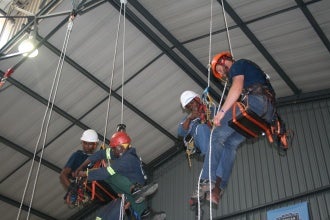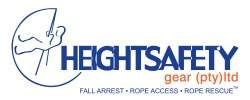
Anyone who controls a place of work is responsible for the health and safety of everyone in that area. This is a simple truth but not fully appreciated by direct employees, contractors and even members of the public.
Managing work at height is difficult. It involves risk assessment and evaluation of risks that cannot always be foreseen. Yet the responsibility remains with individuals that either do the work or those that delegate the work. In both cases the right equipment is the key to avoiding fatalities. Any incident arising from a small negligent act can have serious consequences.
Possibly, one of the most difficult and most challenging of working at height is the use of fall arrest or rope access techniques. Training for this particular discipline is of the highest order and success can only be measured by the ability to perform allotted tasks efficiently and in an economic timeframe, safely.
The Heightsafety Training Academy recently held a competition, The African Rope Access Championship in Gauteng, which was aimed at testing the skills level of employees of various companies who were involved in the business of working at height. The competition was conducted on the basis of recording the fastest time over a combination of four access manoeuvres without any safety mistakes and that the contestant remained safely on at least two points during the manoeuvre.
The manoeuvres on which the contestants were measured were:
- Ascend and descend through a deviation past knots, through a re-belay and back to the ground. Total height of all the manoeuvres combined is a total of 8m
- A short line transfer into a long line transfer into a loop and down to the ground. This runs in a triangle and all ropes (for the transfers) needs to be prepared and connected with the technician’s harness before the start. The time stops when the technician is back on the ground where he/she started
- A combined aid climbing exercise. The technician will access the aid climbing routes with an access rope from the ground. A combination of steel beams and eye bolts need to be aided by making use of short slings and direct connection. A total number of fourteen eye bolts need to be crossed as well as two sections of 3m beams. Once the technician reaches the other side he needs to transfer to a set of access ropes and abseil down to the ground. No tiebacks of cow tails onto the beam are permitted
- Pick off rescue, where the victim is stuck on a descender about 5m from the ground. The rescuer needs to access the victim on the same set of working ropes, accessing the victim from underneath
The event was held over two days and was a resounding success with all the participants; highly focused, reminiscent of prize fighters going into the ring. Adding to the atmosphere and as a sure motivation was the strains of the music from the movie Rocky in the background.
The event ended on a high note with the winners being announced:
- 1st prize – JJ Conradie with a total time of 20 minutes and 16 seconds
- 2nd prize – Terence Selowa with a total time of 21 minutes and 33 seconds
- 3rd prize – Vincent Motshaisa with a total time of 21 minutes and 39 seconds
The next event is being held in Cape Town and aims to be as successful. Safety is a key word in working at height and more events of this nature will be invaluable in ensuring an accident-free environments for workers.
Image: The African Rope Access Championship tested the skills of employees working at height. Photo: courtesy of Heighsafety Gear.

